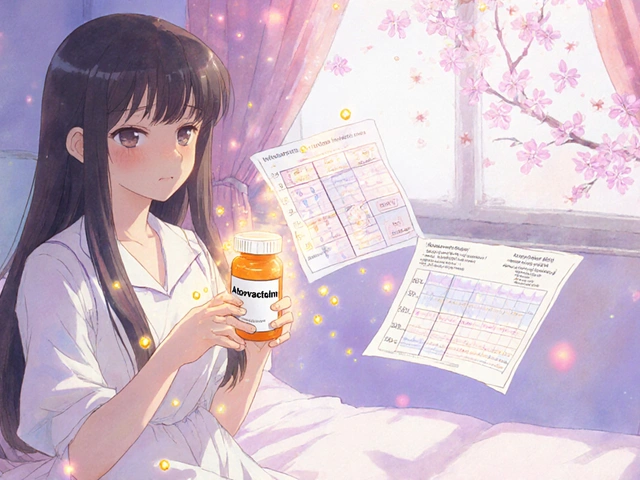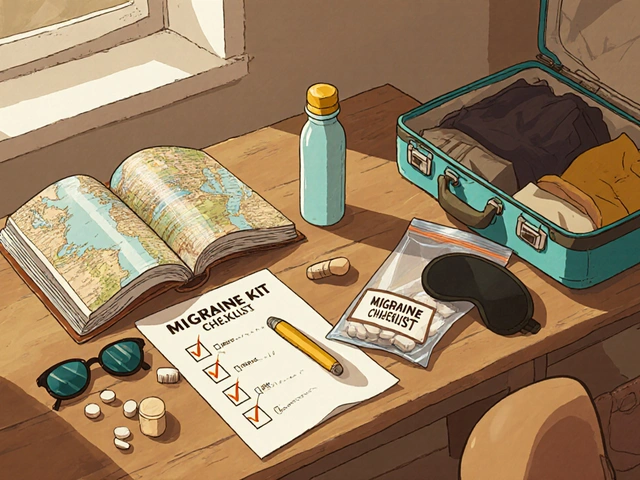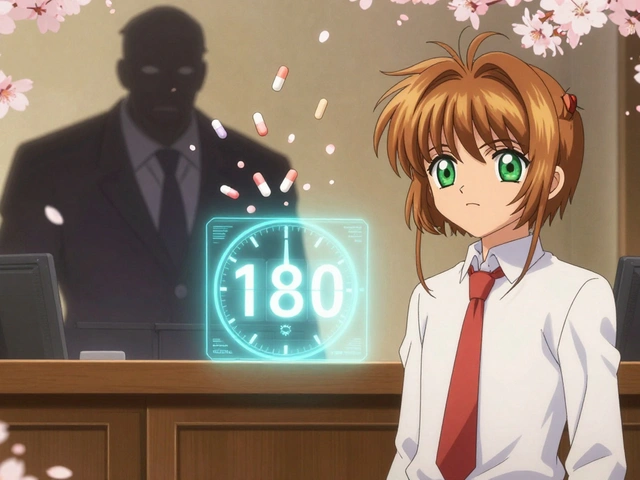Medication-Induced Orthostatic Hypotension Risk Calculator
Risk Assessment Tool
This tool estimates your risk of medication-induced orthostatic hypotension based on your age, medications, and number of prescription drugs you take.
Results
Ever stand up and feel the room spin? That sudden light‑headedness is often a sign of orthostatic hypotension, especially when a drug is the hidden culprit. This guide breaks down what medication‑induced OH looks like, who’s most vulnerable, how doctors confirm it, and what you can do right now to stay steady on your feet.
Key Takeaways
- Orthostatic hypotension (OH) is defined as a drop of >20 mm Hg systolic or >10 mm Hg diastolic within three minutes of standing.
- Up to 30 % of OH cases are caused by medications such as opioids, antipsychotics, alpha‑blockers, diuretics, and Parkinson’s drugs.
- People over 70 or those on four or more meds face a three‑ to six‑fold higher risk.
- Simple steps-reviewing meds, staying hydrated, using compression stockings, and rising slowly-resolve symptoms in 65‑80 % of patients.
- If non‑pharmacologic measures fail, low‑dose midodrine can reduce dizziness in about two‑thirds of cases.
What Exactly Is Orthostatic Hypotension?
Orthostatic Hypotension is a clinical condition marked by an excessive fall in blood pressure when a person moves from lying or sitting to an upright position. It isn’t a disease on its own; it’s a symptom of the body’s inability to keep the brain supplied with blood during postural changes.
Medication Classes Most Likely to Trigger OH
Not every pill lowers blood pressure, but several drug groups interfere with the baroreceptor reflex, cause vasodilation, or dehydrate you. Below is a snapshot of the biggest offenders.
| Medication Class | Typical OH Incidence (%) | Primary Mechanism |
|---|---|---|
| Opioids | 15‑25 | Central nervous system depression + peripheral vasodilation |
| Antipsychotics (e.g., clozapine, quetiapine) | 20‑45 | Alpha‑adrenergic blockade |
| Alpha‑blockers | 25‑35 | Direct vasodilation |
| Diuretics (e.g., hydrochlorothiazide) | 10‑20 | Volume depletion |
| Levodopa (Parkinson’s disease) | 30‑50 | Peripheral vasodilation and impaired autonomic reflexes |
Who Is Most at Risk?
Age is the biggest driver-people 70 years or older are about 3.2 times more likely to develop OH. Polypharmacy compounds the problem; taking four or more drugs raises the odds by roughly 5.7 times. Specific high‑risk agents identified in systematic reviews include tricyclic antidepressants (odds ratio 3.2), alpha‑blockers (OR 2.8), and diuretics (OR 1.9).

How Doctors Diagnose Medication‑Induced OH
The test is straightforward but must be precise. The patient rests supine for five minutes, then BP is recorded immediately on standing (0 min) and again at 1, 2, and 3 minutes. A drop meeting the >20 mm Hg systolic or >10 mm Hg diastolic threshold, coupled with dizziness or light‑headedness, confirms the diagnosis. In up to 40 % of cases the condition can be silent-no symptoms despite the BP fall-so routine screening in older adults is recommended.
Step‑by‑Step Management Plan
- Medication Review: List every prescription, over‑the‑counter, and herbal product. Identify high‑risk agents (see table above) and discuss alternatives with the prescriber.
- Non‑Pharmacologic Measures:
- Increase fluid intake to 2-2.5 L/day unless contraindicated.
- Wear compression stockings (30-40 mm Hg) during the day.
- Rise slowly: sit for a minute, swing legs, then stand.
- Elevate the head of the bed 6-12 inches to reduce nocturnal BP drops.
- Medication Adjustments: Taper or switch high‑risk drugs when possible. For example, replace high‑dose quetiapine with a lower‑potency alternative, or use a selective α1‑agonist instead of a non‑selective α‑blocker.
- Pharmacologic Rescue: If symptoms persist despite the above, low‑dose midodrine (5‑10 mg three times daily) is the first‑line pharmacologic option. Clinical trials show about 65 % symptom reduction.
- Follow‑up Monitoring: Re‑measure BP after each change. Document readings at the same time points (0‑3 min) to gauge improvement.
Practical Checklist for Clinicians and Caregivers
- Ask every patient over 65 about dizziness on standing.
- Record a full medication list, including PRN and supplements.
- Perform the supine‑to‑standing BP test at each visit for high‑risk patients.
- Educate patients on fluid goals and proper use of compression stockings.
- Schedule a medication review within two weeks of any new prescription.
Common Pitfalls to Avoid
Missing the link between a new drug and OH is easy. A frequent mistake is attributing falls solely to aging, which delays the medication adjustment that could solve the problem. Another trap is stopping all antihypertensives at once; a gradual taper prevents rebound hypertension and helps isolate the offending agent.
When to Consider Specialist Referral
If OH persists after medication changes, if the patient experiences syncope, or if there are signs of neurogenic autonomic failure (e.g., minimal heart‑rate compensation), a referral to a neurologist or autonomic specialist is warranted.
Future Directions
Researchers are testing personalized algorithms that weigh genetics, comorbidities, and drug profiles to predict OH risk before a prescription is written. Early-phase trials of selective α1A‑agonists promise to treat the underlying condition without triggering a BP drop.
Frequently Asked Questions
What is the normal blood‑pressure change when I stand up?
A small drop (usually <10 mm Hg systolic) is normal. Anything over 20 mm Hg systolic or 10 mm Hg diastolic within three minutes suggests orthostatic hypotension.
Which common meds should I ask my doctor about?
Start with opioids, antipsychotics (especially clozapine and quetiapine), alpha‑blockers for prostate issues, diuretics, and Parkinson’s drugs like levodopa. Even some antidepressants and antihypertensives can contribute.
Can I prevent medication‑induced OH without stopping my meds?
Often yes. Simple measures-drinking enough water, wearing compression stockings, and rising slowly-help many patients. Dose reduction or switching to a safer alternative is another option.
How quickly does midodrine work?
Most patients notice symptom improvement within 1‑2 weeks of starting low‑dose midodrine, though full titration may take a month.
Should I be worried about falls if I have OH?
Yes. OH raises fall risk by 15‑30 %. Managing the blood‑pressure drop and using safety aids (grab bars, non‑slip shoes) is essential.







Abhinav B. October 25, 2025
Listen up everyone, if you are on opiods or any heavy medcations you need to check your BP before you stand up. In many parts of India we see patients get dizziness because the docs prescribe high dose antihypertensives together with diuretics. The combo can drop your pressure faster than a runaway train. Make sure you drink plenty of water and ask your doctor if you can reduce the dose or switch to a safer alternative. Standing up too fast after a long nap is a recipe for a light‑headed spell.
Sarah Keller October 25, 2025
When we contemplate the act of rising from a seated position, we are reminded that the body is a finely tuned system, ever‑ready to adapt, yet vulnerable to the subtle influences of pharmacology. The very drugs intended to heal can betray us, unmasking a hidden fragility that manifests as orthostatic hypotension. Consider the cascade: a medication that dilates vessels, the baroreceptor reflex blunted, and suddenly the brain is starved of its oxygen supply. This is not merely a clinical footnote; it is a lived experience for countless seniors whose independence teeters on the edge of a single misstep. The statistics are stark-up to thirty percent of OH cases stem from our own pharmacopeia, a reminder that every prescription carries weight beyond its intended target. We must therefore adopt a holistic lens, scrutinizing each drug not in isolation but as part of an intricate network of interactions. Polypharmacy, especially in those over seventy, amplifies the risk, creating a perfect storm where a modest dose change can tip the balance. It is incumbent upon clinicians to perform diligent medication reviews, to question the necessity of each agent, and to prioritize non‑pharmacologic strategies whenever feasible. Patients, too, should be empowered with knowledge, understanding that rising slowly, staying hydrated, and using compression stockings are not merely suggestions but vital safeguards. Let us champion a collaborative approach, where physicians, pharmacists, and patients co‑create a plan that respects both therapeutic goals and the body's delicate equilibrium. In doing so, we transform a potentially hazardous side effect into an opportunity for proactive care, preserving dignity and stability for those we serve. This philosophy aligns with the broader ethic of medicine: to do no harm, even when the harm originates from well‑intentioned interventions.
Veronica Appleton October 25, 2025
Quick tip: keep a log of any dizziness episodes and note the time you stood up it helps the doc pinpoint the problem faster.
the sagar October 25, 2025
Big pharma hides the truth about these pills.
Grace Silver October 26, 2025
Orthostatic drops are a reminder that our bodies are not machines they need gentle transitions. If you rise slowly, pause, swing your legs, you give your circulatory system time to adjust. Think of it as a mindful moment before you start your day.
Clinton Papenfus October 26, 2025
Dear readers, I would like to stress the importance of comprehensive medication review. Please consult your healthcare provider about possible adjustments. Maintaining optimal hydration and employing compression stockings are highly recommended measures. Let us all commit to proactive management with diligence and enthusiasm.
Zaria Williams October 26, 2025
Honestly, if you're still on those old antipsychotics you might as well be living in the 90s. The side effects are insane and nobody seems to care. People need to wake up and demand newer, safer alternatives. It's not just a minor inconvenience; it's your life at stake.
ram kumar October 26, 2025
Ah, the tragic saga of modern medicine! One moment you are a thriving individual, the next you are shackled by dizzy spells, all because some overzealous prescription was handed down without a second thought. It's a drama worthy of Shakespeare, yet we suffer in silence, our very vitality draining like a candle in a storm. The elite prescribers, perched upon their thrones of knowledge, seem oblivious to the suffering below. I implore you, dear readers, to awaken from this malaise and demand accountability!
Melanie Vargas October 26, 2025
Great info! Remember to stay hydrated and wear those compression stockings 😊 If you need help tweaking your meds, reach out to a pharmacist. We're all in this together! 🙌
Tamara Schäfer October 26, 2025
Don't let a little dizziness stop you from enjoying life. Even small changes like sipping water before you stand can make a big diffrence. Keep a positive mindset and work with your doctor to find the best plan for you.